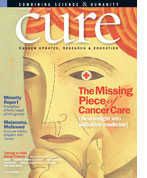Publication
Article
CURE
Web Exclusive: Possible Barriers to Palliative Care
Author(s):
Patients may encounter potential barriers to receiving palliative care, but there are options for overcoming these roadblocks.
It may help you to be aware of some potential barriers to receiving palliative care you might encounter, but don’t let these barriers get in your way. You have a right to palliative care. Your physician and your health care institution should provide you with resources for adequate symptom management and psychological support.
1. Forced Choice: The current Medicare hospice benefit forces people with advanced disease to choose between curative therapies (care that might prolong a person’s life) and hospice care. Currently, for a person to enter hospice, a doctor must certify that he or she is expected to live 6 months or less. Once in hospice, the person receives palliative care, but can no longer receive therapies that are focused on curing cancer. This “either/or” choice has led many people with cancer to only choose hospice care in the last 2 to 3 months of their illness, thus reducing the full benefits that they might receive from earlier help from a hospice program.
2. Knowing When to Say “Enough Is Enough”: People with cancer and their physicians can be reluctant to address the reality that at some point, cure is no longer a possibility and additional treatments with curative intent will be ineffective, and perhaps even detrimental. People with cancer often cannot acknowledge the failure of curative therapies because they lack the education or the will to do so; if they can, sometimes their loved ones cannot. Well-intentioned but misguided family members may insist that the person with advanced disease participate in futile therapeutic interventions. Physicians may not want to be seen as powerless or ineffectual, and may continue to prescribe treatments so as not be seen as “giving up” on their patients.
3. Death—A Difficult Subject: There are strong cultural and societal attitudes against talking about death. Some people with cancer and their families view discussions about end-of-life care as giving up hope. These attitudes can prevent people from receiving the care that they require and deserve.
4. Limited Professional Training and Education for Health Care Providers in Palliative Care: Fewer than 1 in 3 medical schools and residency programs currently integrate palliative care into their professional training, and the same is true of schools of nursing and social work. However, the number of professionals with expertise in palliative care is growing and more and more hospitals and cancer care centers provide these services.
5. Unequal Access and Disparities in Care for Underserved Populations: A thorough discussion of this problem and the variety of potential solutions for it is beyond the scope of this text, but the fact remains that this barrier is profound, significant, and needs to be addressed by the health care system both locally and overall. Current efforts to ensure that every person in need has access to quality palliative care regardless of race or ethnicity, geographic location, or socioeconomic status—such as those spearheaded by the National Resource Center on Diversity in End-of-Life Care (866-670-6723 or http://www.nrcd.com)—are a good start.
6. Other Barriers: A lack of standards of accountability in caring for dying persons, inadequate information on palliative care services for the public, and lack of government support and funding for research and training on end-of-life issues can complicate matters as well.
Reprinted with permission from the American Cancer Society. When the Focus Is on Care: Palliative Care and Cancer. Atlanta, GA: American Cancer Society; 2005, www.cancer.org/bookstore.






